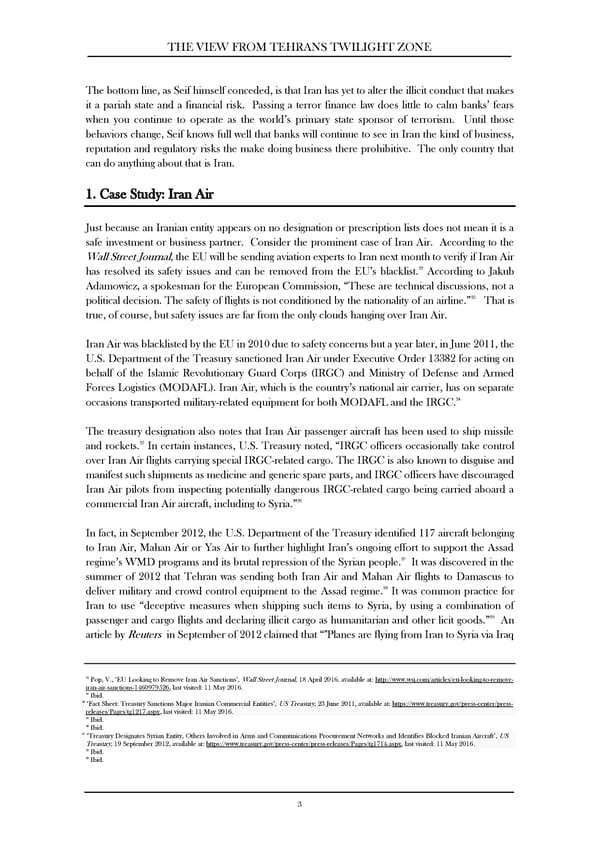THE VIEW FROM TEHRANS TWILIGHT ZONE The bottom line, as Seif himself conceded, is that Iran has yet to alter the illicit conduct that makes it a pariah state and a financial risk. Passing a terror finance law does little to calm banks’ fears when you continue to operate as the world’s primary state sponsor of terrorism. Until those behaviors change, Seif knows full well that banks will continue to see in Iran the kind of business, reputation and regulatory risks the make doing business there prohibitive. The only country that can do anything about that is Iran. 1. Case Study: Iran Air Just because an Iranian entity appears on no designation or prescription lists does not mean it is a safe investment or business partner. Consider the prominent case of Iran Air. According to the Wall Street Journal, the EU will be sending aviation experts to Iran next month to verify if Iran Air has resolved its safety issues and can be removed from the EU’s blacklist.22 According to Jakub Adamowicz, a spokesman for the European Commission, “These are technical discussions, not a political decision. The safety of flights is not conditioned by the nationality of an airline.”23 That is true, of course, but safety issues are far from the only clouds hanging over Iran Air. Iran Air was blacklisted by the EU in 2010 due to safety concerns but a year later, in June 2011, the U.S. Department of the Treasury sanctioned Iran Air under Executive Order 13382 for acting on behalf of the Islamic Revolutionary Guard Corps (IRGC) and Ministry of Defense and Armed Forces Logistics (MODAFL). Iran Air, which is the country’s national air carrier, has on separate 24 occasions transported military-related equipment for both MODAFL and the IRGC. The treasury designation also notes that Iran Air passenger aircraft has been used to ship missile 25 and rockets. In certain instances, U.S. Treasury noted, “IRGC officers occasionally take control over Iran Air flights carrying special IRGC-related cargo. The IRGC is also known to disguise and manifest such shipments as medicine and generic spare parts, and IRGC officers have discouraged Iran Air pilots from inspecting potentially dangerous IRGC-related cargo being carried aboard a 26 commercial Iran Air aircraft, including to Syria.” In fact, in September 2012, the U.S. Department of the Treasury identified 117 aircraft belonging to Iran Air, Mahan Air or Yas Air to further highlight Iran’s ongoing effort to support the Assad 27 regime’s WMD programs and its brutal repression of the Syrian people. It was discovered in the summer of 2012 that Tehran was sending both Iran Air and Mahan Air flights to Damascus to deliver military and crowd control equipment to the Assad regime.28 It was common practice for Iran to use “deceptive measures when shipping such items to Syria, by using a combination of 29 passenger and cargo flights and declaring illicit cargo as humanitarian and other licit goods.” An article by Reuters in September of 2012 claimed that “"Planes are flying from Iran to Syria via Iraq 22 Pop, V., ‘EU Looking to Remove Iran Air Sanctions’, Wall Street Journal, 18 April 2016, available at: http://www.wsj.com/articles/eu-looking-to-remove- iran-air-sanctions-1460979526, last visited: 11 May 2016. 23 Ibid. 24 ‘Fact Sheet: Treasury Sanctions Major Iranian Commercial Entities’, US Treasury, 23 June 2011, available at: https://www.treasury.gov/press-center/press- releases/Pages/tg1217.aspx, last visited: 11 May 2016. 25 Ibid. 26 Ibid. 27 ‘Treasury Designates Syrian Entity, Others Involved in Arms and Communications Procurement Networks and Identifies Blocked Iranian Aircraft’, US Treasury, 19 September 2012, available at: https://www.treasury.gov/press-center/press-releases/Pages/tg1714.aspx, last visited: 11 May 2016. 28 Ibid. 29 Ibid. 3
 The View from Tehran's Twilight Zone Page 5 Page 7
The View from Tehran's Twilight Zone Page 5 Page 7